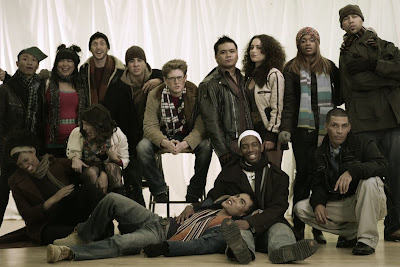
Solomon Guggenheim Museum, NYC, November 2009.

Rockefeller Center, NYC, November 2009.
 On the taxi ride to JFK Airport for our flight home to San Francisco, our Chinese driver was listening to Luis Miguel sing Bésame Mucho as we drove through Harlem, and at that moment, I started to miss New York before I even left it.
On the taxi ride to JFK Airport for our flight home to San Francisco, our Chinese driver was listening to Luis Miguel sing Bésame Mucho as we drove through Harlem, and at that moment, I started to miss New York before I even left it.

 Spending Thanksgiving week in New York was my daughter's idea. She wanted to see the steps of the Met (the Gossip Girl hangout) and the many landmarks she has seen only in movies. As for me, I wanted to be a tourist in the city that was my home for five years.
Spending Thanksgiving week in New York was my daughter's idea. She wanted to see the steps of the Met (the Gossip Girl hangout) and the many landmarks she has seen only in movies. As for me, I wanted to be a tourist in the city that was my home for five years.Soak it up like tourists we did: the illuminated red steps of Times Square; the giant balloons of Macy's Thanksgiving parade; Jude Law, riveting in Hamlet; the prodigious dancer David Alvarez in Billy Elliot; a West Side Story restaged for a politically correct generation; Robert Frank's The Americans at the Met; autumn foliage in Central Park; bargain shopping on Canal Street.

 In Central Park Zoo, the eerie green glow of a tropical rain forest pavilion served as the perfect backdrop for portrait-taking. It reminded me of the mismatched dreamscape of the Mona Lisa, but in the actual portraits appeared more akin to the Sleepy Hollow of Tim Burton, whose work was being exhibited at the Museum of Modern Art (which we sadly missed).
In Central Park Zoo, the eerie green glow of a tropical rain forest pavilion served as the perfect backdrop for portrait-taking. It reminded me of the mismatched dreamscape of the Mona Lisa, but in the actual portraits appeared more akin to the Sleepy Hollow of Tim Burton, whose work was being exhibited at the Museum of Modern Art (which we sadly missed).
 Above all, the trip was about spending an entire week in a city I love with the people I love most. I can't wait to return next year in time for Christmas, under the Star of 57th Street!
Above all, the trip was about spending an entire week in a city I love with the people I love most. I can't wait to return next year in time for Christmas, under the Star of 57th Street!
















































